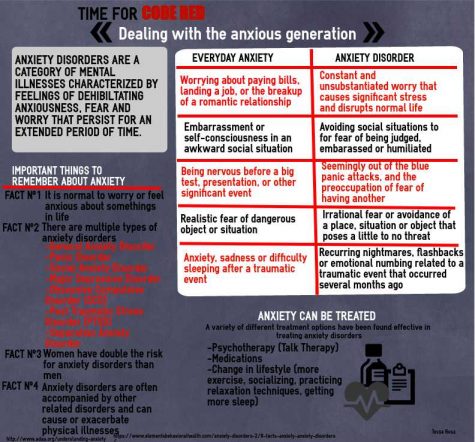Today’s generation deals with increased anxiety
May 12, 2016

The future is now. In a culture that is so focused on preparing for future opportunities, parents are forcing their children’s plans to become more career centric. This is adding more stress to a student’s life to perform well in academics, this stress often leads to anxiety. Anxiety is becoming a more widespread issue in this generation, it is an issue that needs to be talked about and dealt with.
Anxiety disorders are a category of mental illnesses that are characterized by feelings of anxiousness, fear and worry that persist for an extended period of time and cause an individual to be unable to function properly in everyday life. Feelings like these can cause physical symptoms such as shakiness, a racing heart and shortness of breath. Today’s generation experiences first hand the highest levels of anxiety yet. Average teenagers are experiencing the same levels of anxiety as psychiatric patients in the 1950s did. That is a problem, these patients were locked up because their anxiety caused them to be unable to function, society can not lock up a whole generation in hopes of helping them.
According to The National Institute of Mental Health, levels of anxiety have been on the rise since the 50’s. This gradual increase has lead this generation to where they are now; stressed out, anxious and barely functioning.
Dr. Sharon Sevier, chair of the board of the American School Counselor Association as well as a counselor at Lafayette High School in St. Louis, discusse
d how over the last few decades things have drastically changed.“Early in my career, I saw very few mental-health issues, and the home and family issues were more rare,” Sevier said.
Sevier said she encounters more students with anxiety on an everyday basis, years ago she dealt with more normal teenage issues, such as conflicts in relationships. Now, she sees and increase in cases of anxiety and deals with more severe cases than anything else.
The increased amount of testing teenagers have forced upon them contributes to the stress and anxiety that already exists. Not only is it the testing, but the amount of over-commitment. Most students are not only taking on full academic schedules, but sports, jobs, family obligations and social life. These commitments can be hard to balance and often cause mass amounts of anxiety. It might seem like there is a simple solution to downsizing the commitments and therefore downsizing anxiety, but many students feel that these are necessities.
“I didn’t want to put myself under that stress, but I had to. It’s like this battle. There was a lot of pressure to succeed and do the best that I could,” Angelica Marinelli, a typical 17 year old told The Atlantic.
Because students feel that pressure of these seemingly necessary commitments, school nurses and counselors across the country have seen more cases of anxiety symptoms increase each year. If society keeps putting the levels of pressure it currently is on these students, there is no doubt that things will go wrong.
In the 1980s, the third edition of the Diagnostic and Statistical Manual of Mental Disorders stated, “It has been estimated that from two to four percent of the general population has at some time had a disorder that this manual would classify as an Anxiety Disorder.”
Now, looking at the numbers, they have grown. It is the most common mental illness in the United States, affecting 18 percent of the population. Anxiety disorders are amongst the top reasons why students drop out. According to Mentalhealth.com, 22 percent of students say they feel too nervous at school, 16.9 percent had anxiety about speaking in front of the class and 10.9 percent said they felt anxious due to teachers or peers.
Anxiety is becoming a bigger problem with each generation. If today’s teenagers are experiencing the same levels of anxiety as psychiatric patients in the 50’s, it will only continue to grow and become an even bigger problem. It is a huge issue, only growing with time. It needs to be dealt with before it grows bigger and becomes harder to recover from.







